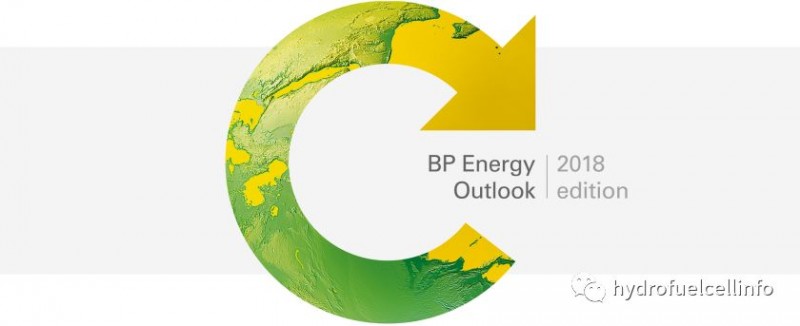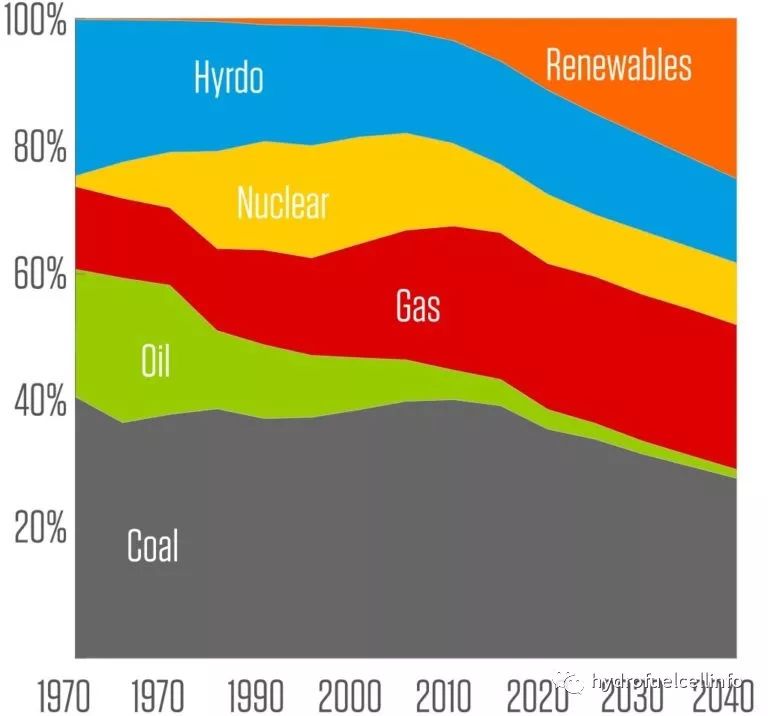BP Energy Outlook Ignores Renewable EnergyOutpacing Fossil Fuels
BP公司2018年能源展望报告忽略可再生能源将会超越化石燃料

British multinational oil and gas companyBP has published its highly-anticipated Energy Outlook for 2018 and, eventhough it has branded its standard model the ‘Evolving Transition’ scenario,this year’s report is the very picture of business as usual for the fossil fuel giant.
英国跨国石油天然气公司BP发布了2018年备受期望的能源展望,尽管BP已经将其标准模型命名为“在演变中的过渡”,但今年的报告对化石燃料行业巨头来说,还是一幅一如既往的商业图景。

BP began publishing its Energy Outlook tothe public back in 2011, and since then the document has actually become somethingof an important marker for those monitoring the global energy space. To becertain, BP stands for British Petroleum, so on the surface, one might considerit biased — sort of like trusting the wolf’s status updates on the contents ofthe sheep pen. I’m not one to dismiss out of hand anything and everything BPsays or does, because we’re not going to make progress unless we incentivize the involvement of fossil fuel supermajors like BP and bring them into theparty. And this year’s BP Energy Outlook 2018 edition does make some allowancesfor the difficulty in predicting the future of the global energy sector.
BP公司从2011年开始公开发表能源展望,自那时开始,BP公司的能源展望的报告,就成了监测全球能源领域的一个重要的标志。可以肯定的是,BP代表的是英国石油公司,所以表面上来看,很多人认为这可能会有些偏见-有些像狼更新了羊圈的内容一样不太值得相信。我不是个完全不相信BP所说的东西的人,因为我们除非鼓励这些像英国石油这样的大的化石燃料的巨头参与进来,不然我们很难取得什么进展。今年BP公司的能源展望,对全球能源行业的预测,确实有些困难。
In its introduction, the authors of theOutlook explain that much of the report is based on their business as usualpredictions — the ‘Evolving Transition’ scenario. “But,” as the authorsimmediately explain, “that does not imply that the probability of this scenariois higher than the others. Indeed, the multitude of uncertainties means theprobability of any one of these scenarios materializing exactly as described isnegligible.”
在报告前言,BP能源展望的作者解释说,报告中的大部分内容是基于他们平常的商业预测-“在演变中的过渡”场景。“但是,”作者又急忙解释到,“这并不意味着说这种情况的概率比其它的要高。事实上,大量的不确定性意味着这些场景中的任何一个概率都是可以被忽略的”。
In other words, let’s give credit where itsdue. Though we might disagree with some of BP’s main takeaways — and trust me,we do — let’s not pretend that any of us are really overly confident in howthings will turn out.
换言之,让我们给BP一些信任吧。尽管我们可能不太同意BP报告中的一些主要的观点-相信我,我们是的-不要假装我们当中的任何一个人对事情的结果显得过于自信了。
All of that being said, it is dismaying tohave all my attempts to give BP the benefit of the doubt undone when youconsider their predictions through to 2040 — the extent of this year’s Outlook.The report is an ‘energy’ outlook, so it covers all aspects of energy aroundthe world. You can get a sense of the report’s scope here.
话虽这么说,但考虑到他们的这个报告预测到2040年,我试图想这个报告能给BP公司带来的好处时,有些沮丧。这份报告是一份“能源”展望,所以它涵盖了世界范围内的各种能源。在这里你能了解一下这份报告的范围。
Spencer Dale
My main point of contention with the Outlook is itsfuel analysis through to 2040. “By 2040, oil, gas, coal and non-fossil fuelseach account for around a quarter of the world’s energy,” explained SpencerDale, group chief economist. “More than 40% of the overall increase in energydemand is met by renewable energy.” In other words, BP is more than willing toacknowledge the impressive growth of renewable energy and its importance as theenergy generation technology of the future.
在这份报告中我的主要的观点是到2040年间的化石燃料的分析。“到2040年,石油,天然气,和非矿物燃料,它们各占世界能源的比例都在1/4左右。”BP集团的首席经济学家Spencer Dale解释说。“超过40%的能源需求增长是通过可再生能源来实现的”。那也就是说,BP公司更愿意承认,可再生能源的惊人的增长速度,以及未来可再生能源发电技术的重要性。
I just think they are missing just howquickly renewable energies are transforming the power sector specifically.
我只是认为他们遗漏了可再生能源是如何迅速的改变了电力行业。
According to the Outlook out to 2040,“renewable energy grows 400% and accounts for over 50% of the increase inglobal power generation.” The lion’s share of the growth is thanks to the“increasing competitiveness of wind and solar” despite the fact that “Subsidiesare gradually phased out by the mid-2020s, with renewable energy increasinglyable to compete against other fuels.” Unsurprisingly, BP acknowledges that“China is the largest source of growth, adding more renewable energy than theentire OECD combined, with India becoming the second largest source of growthby 2030.”
据能源展望2040,“可再生能源增长了400%,占了全球发电量增长的50%以上”。增长最大的份额是“风能和太阳能的竞争力逐渐增强”,尽管“对风能和太阳能的补贴在2020年就会逐渐取消,但可再生能源与其它燃料的竞争日益激烈。不出所料的是,报告中说”中国是增长最快的来源,比整个经济合作与发展组织(OECD)的总和还要多,印度成为2030年第二大增长来源。

Sounds good, right?
听起来不错,对吧?
The issue is less about the companyacknowledging the growth of renewables and more about its consistent beliefthat fossil fuels, especially coal, will maintain their stranglehold on theworld energy mix.
问题不在于BP公司承认可再生能源的增长,而更多的是关于BP公司一贯的信念,那就是化石燃料,特别是煤炭,将会维持它们对世界能源构成的控制。
When you dig into the numbers beyond justthe initial front page and press release you find that, even though BPacknowledges that “the world continues to electrify,” it still believes thatcoal will remain the largest source of energy for power in 2040, predicting a30% share. Yes, coal decreases over that time and renewables expanddramatically, but it still misses current realities.
当你深入到报告首页和新闻发布会之外的数字时,你会发现,尽管BP公司承认“世界在继续电气化”,但他们仍然坚信到2040年,煤炭仍然是最主要的能源来源,并预测到占到30%的比例。是的 ,那个时候,煤炭是在不断的减少,可再生能源在逐渐的增加,但他们仍然忽略的当下的现实。
The mix of fuels used in power generationis set to shift materially, with renewable energy continuing to gain inimportance
发电所用的混合燃料,已经在物质上发生了转变,可再生能源的重要性仍然在不断的增长。
I’m not simply poking holes in BP’spredictions — as already mentioned, good luck getting that right at this point— but rather at their seeming ignorance of the trends already evident. Coalisn’t just going to disappear one day, it is disappearing right now withmassive closures across Europe and project cancellations in China.
我不是简单的想找BP公司预测的漏洞-就像曾经说过的,在这点上祝你好运-但他们似乎是对已经非常明显的趋势一无所知。煤炭并不会在一天内消失,它正在逐渐的消失,在欧洲有大量的工厂被关闭,在中国有很多的项目已经被取消。
“We agree with BP that electrification is amega-trend that will change the energy sector in ways previously unimaginable,”said Laurence Watson, a data scientist with London-based not-for-profit thinktank the Carbon Tracker Initiative. “However, we see the future energy systempredominantly supplied by cheap wind and solar backed up by a combination ofstorage, demand response and gas. For coal, national phase-outs in Europe,large-scale cancellation of projects in China, and global progress on carbonpricing should give BP pause.”
“我们同意BP公司所说的,电气化是一股巨大的潮流,并以之前不可想象的姿势改变世界能源结构”,位于伦敦的一个非盈利智库,Carbon Tracker Initiative(碳追踪计划)的一个大数据科学家,LaurenceWatson说。“然而,我们能看到的是,在未来,能源系统将会被廉价的风能和太阳能所主导,由存储,需求响应和天然气的组合所支撑。对于煤炭来说,欧洲国家正在逐渐的淘汰,中国进行了大规模的项目取消,还有全球碳定价方面的一些进展,BP公司应当要三思而后行。”
“BP’s costs for renewables are already outof date. Remarkably, solar PV tariff prices in India have declined nearly 80%since 2011. This price decline means solar PV is no longer just a threat to newcoal investments.”
“BP公司的可再生能源的成本已经过时了。值得一提的是,自2011年来,印度的太阳能光伏的价格下降了80%,这个价格也就意味着说,太阳能光伏不再是对新煤炭投资的威胁了。”
I will give BP credit. Its renewablespresentation highlights an alternative scenario for the growth of renewables —its ‘renewables push’ scenario which sees renewables account for more than 90%of growth in power demand by 2040 (compared to over 50%). However, as BP notes,accurately, “The pace at which renewable energy penetrates the global powersystem depends partly on the size and persistence of government support.” InBP’s Evolving Transition scenario support for renewables is largely phased outby the mid-2020s — a not-unlikely event, given the current malaise ofgovernment support for renewable energy technologies. In its ‘renewables push’scenario, however, government support persists until 2040 and, unsurprisingly,punches renewables through the roof, squeezing out room for coal and gas.
“我相信BP公司。他们的可再能源报告强调了可再生能源增长的另外一种方案-那就是”可再生能源推进“,到2040年,可再生能源占电力需求增长的90%以上(跟超过50%相比)。然而,BP公司也精确的指出,”可再生能源进入全球能源系统,部分上是依赖于政府的支持的力度和连续性。”在BP公司的演变中的过渡场景中,对可再生能源的支持基本上在2020年中期就会停止-考虑到目前政府对可再生能源技术的支持有点萎靡不振,这种事情不是没可能发生。然而,在BP公司的“可再生能源推动”的方案中,政府的支持一直会持续到2040年,没有意外的是,可再生能源将会通过屋顶,挤压煤炭和天然气的空间。
But, and on this score I’m with BP, thecurrent situation does not necessarily back the idea that governments will pickup the mantle of support for renewable energy beyond 2020, unless somethingdrastic happens, which I simply don’t see happening at this point. Governmentsupport in major markets like the United States, the UK, Australia, and partsof Europe are sliding, and though renewables are gaining traction in emergingmarkets such as Latin America and Asia, it is not guaranteed that they willbreak with the pattern and continue to support renewables past their massadoption.
但是,就这个理由来说,我站在BP这边,目前的情况并不一定支持政府将在2020年以后为可再生能源提供支持的想法,除非有一些重要的事情发生,而就这点上来说,我没看出来什么迹象。在一些主要的市场,像是美国,英国,澳大利亚,和部分的欧洲国家的政府,对可再生能源的支持有所下滑,尽管在拉丁美洲和亚洲等新兴市场可再生能源获得了越来越多的关注,但这也不能保证他们会打破这种模式,并对可再生能源的大规模采用继续支持。
BP’s Energy Outlook for 2018 digs into manymore aspects of the world’s energy sector, and it’s all worth a look if you’reinterested. But in the end, while BP may have given short shrift to the renewable energy industry, I think it has accurately predicted the currentstate of support for the sector — and there’s only so much the renewable energysector can do on its own.
如果您有兴趣的话,BP公司2018年能源展望报告确实值得一看,它深入研究了世界能源领域的多个方面。但最后,BP公司可能对可再生能源行业暂时有所忽略,但它准确的预测了目前对可再生能源领域的支持情况-而且,可再生能源行业也只有自己可以依靠了。








 扫一扫关注微信
扫一扫关注微信